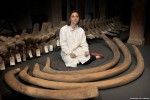 A team of archaeologist excavating the bank of the Thames in Bay Wharf, in the east London neighborhood of Greenwich, discovered a huge skeleton of a decapitated North Atlantic right whale.
A team of archaeologist excavating the bank of the Thames in Bay Wharf, in the east London neighborhood of Greenwich, discovered a huge skeleton of a decapitated North Atlantic right whale.
The skeleton is 7 meters (23 feet) long, 4 meters (13 feet) wide at its widest part and weighs half a ton. The head would have been a third of the whale’s body length, so the critter would have been at least 11 meters (36 feet) long in total when it was alive. It is the largest object ever excavated in London. Historians estimate that he died in the late 18th or early 19th centuries, but we won’t know for sure until his bones are carbon dated.
So how did this badboy find his way from his home somewhere around Greenland to London? There have actually been whales who wandered upriver and beached themselves before. There are historical references to whales in the Thames, and one beached itself as recently as 2006.
 This fellow probably didn’t make it all the way there on his own, however. The placement of his skeleton on the bank — tail forward — suggest he was dragged to shore, but one of the reason right whales were so prized (and hunted to near extinction, natch) is that they float when dead so whalers could easily butcher them. They wouldn’t have killed it in the open ocean then dragged the entire 60-ton carcass into the city to strip it of its valuables.
This fellow probably didn’t make it all the way there on his own, however. The placement of his skeleton on the bank — tail forward — suggest he was dragged to shore, but one of the reason right whales were so prized (and hunted to near extinction, natch) is that they float when dead so whalers could easily butcher them. They wouldn’t have killed it in the open ocean then dragged the entire 60-ton carcass into the city to strip it of its valuables.
[It] may have been harpooned in the Thames estuary or beached itself on the Essex or Kent banks, before being seized by whalers who would have towed it to Greenwich for butchering. It is rare for whales to enter the Thames estuary, but sometimes they become disoriented and stray far from their normal habitats.
The Greenwich area – especially Blackwall and Rotherhithe – used to be a base for whaling fleets that combed the far north of the Atlantic searching for just such prey. To find one on their doorstep, delivered for nothing, would have been a godsend.
But how much the whale merchants would have gained from the carcass is unsure, as any whale which beached itself between the low and high tide marks would have legally belonged to the Crown. It could have been worth up to £4,400 (or £400,000 in today’s money) in oil and whalebone.
 Any whalers involved would have taken the head and left the rest of the carcass for Londoners to butcher on the spot.
Any whalers involved would have taken the head and left the rest of the carcass for Londoners to butcher on the spot.
As so often happens on the banks of the Thames, the thick mud preserved the skeleton in ideal anaerobic conditions. It went on display today in the foyer of the Museum of London Dockland where it will remain just until September 14th. After that, it moves to a permanent new home at the Natural History Museum where it will be studied in depth.
Preliminary examination by zoologists at the Natural History Museum indicate that the whale had reached full maturity. Some of the vertebrae in the tail had fused together, so he probably had a harder time moving his tail than his cohorts, making him more susceptible to beaching or capture.
There are only 300 or so North Atlantic right whales left in the western North Atlantic today, so DNA and isotope analysis of this historic skeleton will help expand our limited knowledge of the species’ genetic diversity, ocean movements and feeding techniques.